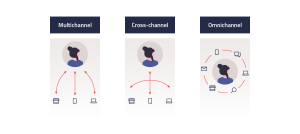Marketing
How to delight your customers with Multichannel Marketing in B2B and B2C

Content
The Impact of Multichannel Marketing
In the world of marketing, one thing is beyond all question: Customers do not only expect high-quality products but also a smooth purchasing experience across various channels.
And this is where Multichannel Marketing comes into play. Companies are to address their target groups on many different platforms, be it through websites, social networks, or direct sales. In this article, we dive into this fascinating world of marketing and explore the unbeatable alliance of Multichannel Marketing and Product Information Management (PIM).
What is Multichannel Marketing?
Multichannel Marketing is the strategic approach of reaching out to customers across multiple channels. To this end, it’s imperative to find just the right mix between online and offline channels in order to adequately address the target group. By utilizing more channels, companies can enhance brand awareness and increase the chance of attracting potential customers. Multichannel Marketing enables companies to make contact with their target group in an even more targeted manner and provide them with personalized offers which, finally, result in higher customer satisfaction rates.
Possible channels are:
- your own online shop
- physical stores
- presence on events and conventions
- e-mail marketing via newsletter
- social networks such as Instagram or Facebook
- guest blogposts on popular blogs
- flyers and product catalogs
- shopping apps
- online marketplaces such as Amazon or eBay
- a product portal which retailers can use to inform themselves about the manufacturer’s product
Are there Differences between B2B and B2C?
Indeed, there are differences in Multichannel Marketing between the B2B and B2C field. This is because not only the target group but also the demands, purchasing decisions, and channel preferences deviate between the two.
In the B2B field, the sales process is, often times, more complex and the sales cycle can be longer. Decisions made are tied to higher costs and risks, which is why personal interactions and more comprehensive sales channels such as sales partners and direct sales are preferred.
In contrast to this, the sales cycle in the B2C field is shorter and purchase decisions are more impulsive. Most of the time, B2C consumers make purchases in small quantities and prefer to carry out their research on the internet or through social media. This is the reason why B2C companies put stronger focus on digital marketing, online sales, and digital channels.
However, there are more and more overlaps between the two fields. B2B companies continue to tap more into digital sales channels, whereas B2C companies integrate personal sales as an additional service option. The right multichannel strategy depends on the specific requirements and preferences of your target group.
Multichannel Marketing in B2B
In order to get a better picture of what Multichannel Marketing looks like in the B2B field, let’s have a look at a fictitious manufacturer for industry equipment from tools and materials to machines. Our example company adopts a comprehensive sales strategy based on a variety of channels such as online platforms, specialist retailers, sales partners, and direct sales.
This rich scope offers higher accessibility and allows business customers the freedom to opt for their preferred ordering method. They may feel more comfortable buying from a retailer’s online shop or purchasing the products in person from the specialist retail stores of sales partners. Furthermore, there is always the option of direct sales (D2B), where manufacturers can purchase directly from the manufacturer. This holistic approach enables our manufacturer of industry equipment to respond to the customers’ requirements in the best possible manner and provide a smooth purchasing experience.
Multichannel Marketing in B2C
An instructive example for Multichannel Marketing in the B2C field would be a retailer who offers their broad product assortment both online via an e-commerce platform as well as physically in shops, pop-up stores, and at conventions. Additionally, such a retailer can tap into a mobile sales channel by offering goods on an app or a popular social media platform such as Instagram for sale.
For customers, this means an abundance of possibilities: They can decide based on their individual preferences whether to purchase it on the internet from the comfort of their own home or seek inspiration in the stationary store live on site. The connection between online and offline channels offers them a purchasing experience without any gaps at the highest flexibility.
Be it B2B or B2C, with the skillful integration of multiple sales channels, companies can not only increase their reach but also interact with customers in a large number of ways. This approach boosts the market presence and does also allow for many opportunities of presenting the own offer in unique ways. This will win the customers’ trust.
The 3 Challenges of Multichannel Marketing
Individual Customer Approach:
Today’s consumers are more demanding than ever. After all, they have the privilege of free choice. The range of offers is enormous, everything is available anywhere anytime. In the light of this abundance, it’s no longer sufficient to simply convey a suitable message to the right target group. The key is, much rather, to approach the customer at just the right time – namely, when her needs, attention, and willingness to buy is at its highest. Addressing customers in an individualized manner is central for capitalizing this decisive moment and building sustainable B2B or B2C relationships.
Tailor-Made Campaigns:
Humans are habitual animals – a figure of speech all of us have already come across. Your customers, too, have their own habits when it comes to browsing certain channels. And, just as the saying goes, old habits die hard. Customers will not change their ways no matter how great the incentive. For companies, therefore, it’s imperative to optimize their marketing measures across all channels – continuously, with further and further improvements. In the process, it’s important to provide a flexible combination of related channels and provide customers of individual touchpoints with targeted micro-campaigns. The most important objective is to close the gap between you and the individual customer by adapting to the demands of the specific situation, hereby amplifying the relevance of your message.
Qualified Analysis of Channels and Touchpoints:
In a marketing environment with ever-increasing interconnectedness, it’s becoming increasingly more difficult to analyze the real contribution a single channel, campaign, or touchpoint makes to the overall sales and profits. Knowledge of this, however, is decisive for reliable success control as well as the steering of marketing and advertisement measures. Only if you can trace back which aspect has contributed to a higher engagement rate of your target group, you can adequately judge whether or not your budget and resources have been allocated optimally.
Mastering these challenges demands an even more well-planned interconnection of the different marketing channels. Only this, after all, can establish an efficient flow of data and information. This strategic evolution of Multichannel Marketing is referred to as Omnichannel.
How does Multichannel Differ from Cross-channel and Omnichannel?
These three strategies differ as follows: In Multichannel, the various channels operate independently of one another, without any overlaps or interaction. Customers can’t jump directly from one channel to another. When it comes to Cross-channel Marketing, in contrast, there is a data exchange between channels – but the message may not necessarily be consistent across all of them. Here, customers can switch between all channels between which such data exchange is possible. Omnichannel Marketing takes this approach even one step further by smoothly interconnecting all these channels with one another. Every channel embodies the uniform brand message together with all usage information. Only this can guarantee that customers will enjoy a customer experience without any gaps.
In short: The main difference between Multichannel and Omnichannel Marketing consists in the fact that Omnichannel Marketing offers a smooth, integrative experience for all channels, while Multichannel Marketing merely means that many channels are utilized but without such a smooth integration. Cross-channel Marketing occupies the middle ground between the two, though the boundaries are fluid.
How can a PIM System Support Your Multichannel Strategy?
Given the large number of different channels, it’s time-consuming to provide the respective product information in the right form per channel, for example the text length of product descriptions or the number of images. Especially considering that you also need to continuously maintain each channel. This is far removed from what a single source of truth has to offer. In a PIM system, product information is managed in a media-neutral manner and independent of specific target channels. For exports into online shops or for physical flyers, this data can then be adjusted for relevant channels. In the process, you may, for example, choose a shorter product description than for the online shop while also limiting the number and adapting the choice of images accordingly. With the help of the quality rules configured in the PIM, you can make sure that the product data quality does always conform with the target channel. Accordingly, the implementation of new channels such as apps for mobile end devices is easier to handle since the master data is already well-maintained and available in the PIM, so all that’s left to do are some channel-specific adjustments.
From Our Blog
You may also be interested in the following articles








